~~~~~~~~~~~~~~~~~~~~~~~~~~~~~~~~~~~~~~
AIA Peconic
Daniel J. Rowen Memorial Design Awards / 2024
——— Awards Presented April 13, 2024 ———-
The AIA Peconic Design Awards is an annual award program that celebrates firms and individuals who demonstrate their outstanding architectural excellence and advance the architectural discourse on the East End of Long Island. At its annual Design Awards Celebration, held at the Ross School on Saturday, April 13, AIA Peconic awarded eight awards for design including the second annual Sustainable Architecture Awards, as well as the second-annual AIA Peconic Community Award which was given to Southampton Town Supervisor Maria Moore.
~~~~~~~~~~~~~~~~~~~~~~~~~~~~~~~~~~~
ARCHITECTURE HONOR AWARD 2024
Three Mile Harbor — Paul Masi AIA, Bates Masi + Architects LLC
———————
ARCHITECTURE MERIT AWARDS
- Navy Beach — Paul Masi AIA, Bates Masi + Architects LLC
- Ocean Bluff — Michael Lomont, Stelle Lomont Rouhani Architects
- Springy Banks — Viola Rouhani AIA, Stelle Lomont Rouhani Architects
———————
HISTORIC PRESERVATION and ADAPTIVE REUSE
MERIT AWARD
—– Round House — Stuart Basseches, AIA
———————
UNBUILT PROJECTS JUROR AWARD
—– Bridge Gardens — Nilay Oza AIA, Oza Sabbeth Architects
———————
SUSTAINABLE ARCHITECTURE HONOR AWARD
—– The Hampton Maid — Richard Stott, AIA, LEED AP
———————
SUSTAINABLE ARCHITECTURE MERIT AWARD
—– Diffusing Hut — Hideaki Ariizumi, studio a/b architects
———————
PEOPLE’S CHOICE AWARD
—– Southampton Oceanfront — Blaze Makoid, BMA Architects
~~~~~~~~~~~~~~~~~~~~~~~~~~~~~~~~~~~~~~~~~~~~
-

- ——————————
- AIA Peconic expresses gratitude for all who submitted projects and to the esteemed jurors for sharing their time and expertise.
- ===================================================
2024 Architecture Honor Award
——————

THREE MILE HARBOR
Paul Masi AIA, Bates Masi + Architects LLC
————————
Juror Comments: In this extraordinary project, the house and site design are negotiating and responding to the long, narrow sliver lot that is ten times deeper than wide.
The house and landscape strategy was to stretch and attenuate the house form and its indoor and outdoor spaces along a linear line that widens and splays open as it reaches closer to the water views and edge. The house invokes a sense of movement and form akin to a vessel slicing and gliding through the water.
There is an extraordinary attention to materiality, details as emotional effect, that modulates the house form, space, light, and view. These “tonal” moments of motion and emotion are elegantly combined to create intimate spaces of rhythmic space and pace. It performs much like the water and maritime atmosphere it reaches out to and resonates with. To quote Lawrence Halperin a bit out of context, it is a building environment that exists for the purpose of movement.
=============================================
2024 Architecture Merit Award
——————

NAVY BEACH
Paul Masi AIA, Bates Masi + Architects LLC
Juror Comments: The jurors admired this house for the simplicity and economy of a design strategy of material separation. A careful study and contrast between a masonry, sand-cast brick base wedged into the existing hillside with an upper level of delicate wood framework, materials and surfaces that stand lightly above this heavy masonry plinth and hillside.
The elongated flow of interior living spaces, wood finishes, and surfaces connect beautifully with the diaphanous coniferous wood siding and woodland beyond. This is a careful and sensitive study of indoor and outdoor living.
——————————————-
Credits & website link at end of portfolio.
=============================================
2024 Architecture Merit Award
——————
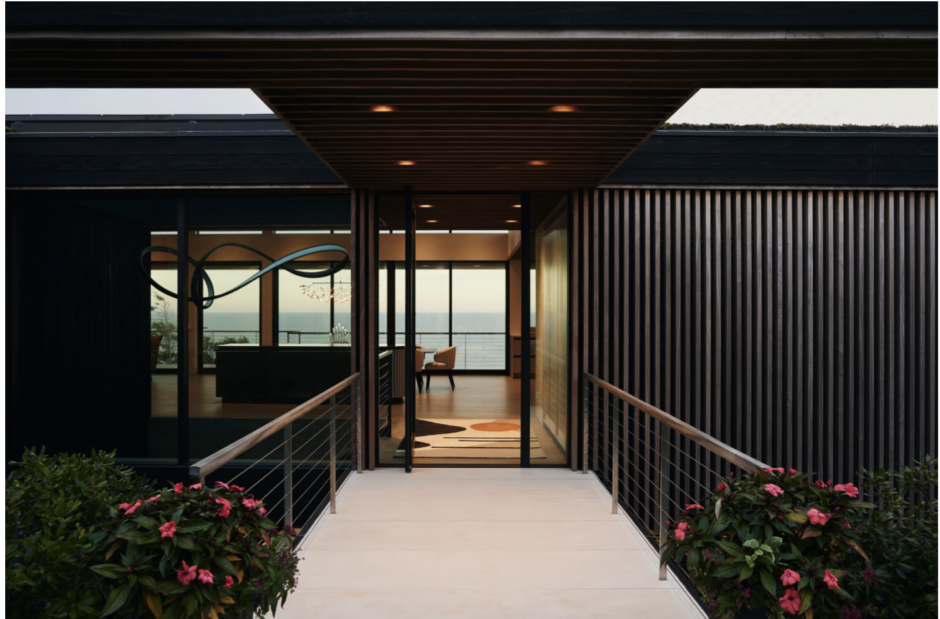
OCEAN BLUFF
Michael Lomont, Stelle Lomont Rouhani Architects
across the dunes to the ocean below.
Jurors Comments: A direct and simple response to steeply inclined site with dramatic horizon views of water and sky sets the stage for a sectional parti based on a series of horizontal datums that delineate both the terraced landscape and in the horizontal roof planes of the house. These horizontal planes organize and integrate the house plan and elevations with the site topography. This is can be seen most clearly in the sectional drawings. There is an economy of moves, both formally and materially, that allows the house to become a backdrop to its surrounding landform.
Architects on this project were Michael Lomont, Jared London, and Jonathan Walker.
——————————————-
Credits & website link at end of portfolio.
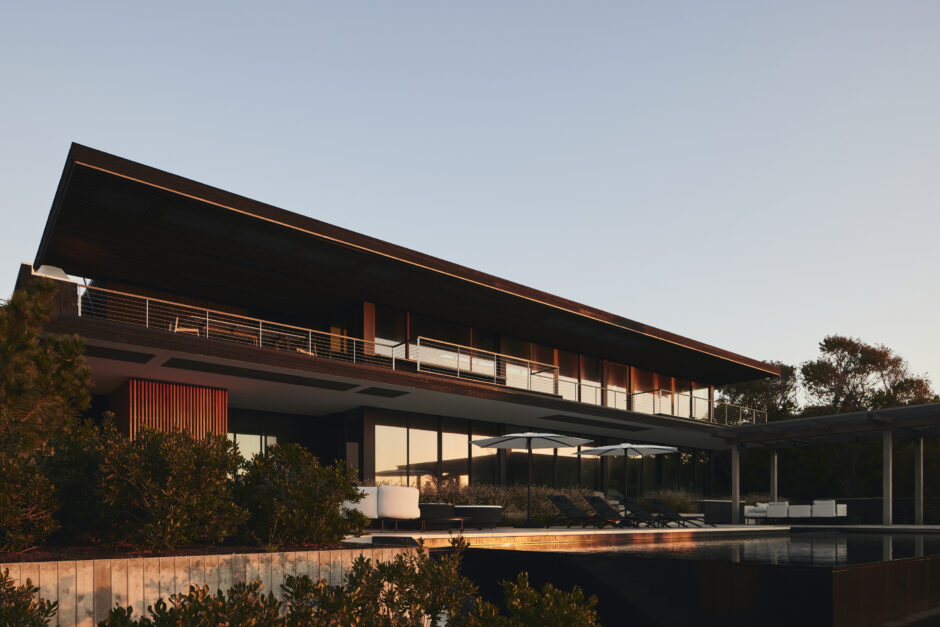
=============================================
2024 Architecture Merit Award
——————
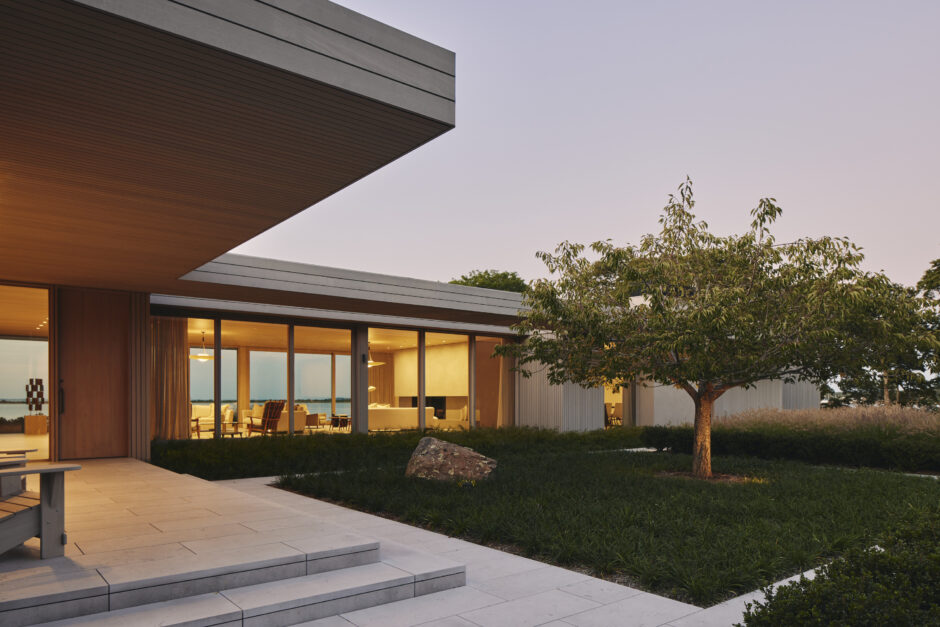
Springy Banks
Viola Rouhani AIA, Stelle Lomont Rouhani Architects
The east end of Long Island is a land of layered histories, and the area known as Three Mile Harbor is no exception. The waterfront properties surrounding the harbor once supported generations of farmers who shipped salt hay to Connecticut. Prohibition era rumrunners, boaters, and more recently boating pleasure seekers have all been documented on its shores. Before any settlers came along, this land belonged to the Native Americans, whose remnants of arrowheads are still being catalogued today. It’s an ongoing careful study that dictates where we can and cannot build. When we were first approached to explore the possibilities of one of the perhaps more notorious properties along the shore, the property known as the former Duke Estate, our first thoughts went to these histories, and the land that afforded them.
Mr. Duke was well known for his charitable contributions. He created the Boys and Girls harbor, a camp for underprivileged city youth to come and be one with nature, next to the property where he once lived himself. The trails and rugged outdoor area that once housed the camp has since been purchased by the Town of East Hampton and Suffolk County, preserved for recreational use by the public. The Duke property itself saw change after the original house burned down, and another, not particularly sensitive to the site was put in its place. Our initial involvement was to try to make sense of the site, made up of three separate properties, in collaboration with the Landscape architects. Thoughts were initially floated to try and preserve the house that sat at the very end of a long straight driveway. The house blocked the view of the water and made for an awkward space between it and the bluff, which dropped steeply off into the shore.
We decided that saving the house in its current location, with its disregard to the history and the potential for celebrating the landscape the way it deserved to be, was not a road we were interested in taking. We respectfully recused ourselves from the project happy to be at the owners’ disposal should they change their mind about how to approach the property. It was not long before we got the call to please go ahead and work with the Landscape team to reimagine the site the way we thought would do it justice. Our first step was to work on remediation of the waterfront, and to think of how best to address the three properties that made up the project. We knew we wanted a new house to pull away from the water, to allow land and space between the two, both as a rehabilitation measure, and out of respect for both.
We also wanted the experience of the land to begin at the street in a way that would clearly start the story right out of the gate so to speak. This was a clear departure from the existing straight driveway that took the trees for granted. A carefully crafted driving path, weaving its way through the original indigenous and supplemented native landscape allows for a full appreciation of the forest. We were careful to site the house in such a way that the approach would foremost allow for the view of the water ahead before having any structure come into play. The house itself is a low-slung affair, clad in grey stained wood siding, to help it along with its weathering, the goal being to have it recede and blend completely with the landscape over time. The notion of the camp figured large as well. Instead of over building the three properties, each is given a specific program with room to breathe. The largest holds the house, nestled into the natural topography, with its view of the bluff. It is separated with a continuation of the forest landscape from a tennis court, that is all but hidden from view at the initial approach. Another of the properties holds a simple wood enclosure, with a covered porch. It’s a pool house that offers shelter by the pool, which has a clear view of the water as well, quite pulled away though to allow the space and distance for contemplation. The third property is mainly left untouched but for a vegetable garden. This site is hillier and forested and becomes a destination. Paths join the various structures.
The house itself is long and low. The main floor is the ground floor, and it has a direct connection to the ground. The restored bluff and the water are to the north and views of same are accessed across the length of the house. An open porch, with hideaway screens to the east, offer the indoor-outdoor element so often sought, above it a roof deck for further vistas both of water and trees. The southside is open to a created garden, rife with flowering cherry trees, it’s the only constructed seeming landscape on the premises. Floor to ceiling wood framed glass covered by a continuous overhang to protect the house allows for the feeling of living on a big porch. As the grade falls off to the west, the lower story with its bedrooms and recreational spaces benefits from the light and access on this level as well.
The interiors of the house carry the warmth of wood inside. Walls are painted a muted white and become the backdrops to art, both physical art and the beautify of the surroundings. Each solar direction is framed and captures a unique appreciation of the land both in its present and past incarnations.
————————
Juror Comments: This is a thoughtful and careful study of the cultural and ecological landscape of an historic site that extends well beyond the house. We admired the quiet, reserved scale of the approach to the house and its restrained use of single material of stained wood siding. It is delicately situated into diagonal slope of the coastal bluff and gives a sense of single story house in open woodland that is pulled back from the coastal ecology. The overall effect is a relatively large house that settles into its larger woodland and coastal landscape with ease and a minimal presence.
——————————————-
Credits & website link at end of portfolio.
=============================================
Historic Preservation and Adaptive Reuse Merit Award
——————

ROUND HOUSE
Stuart Basseches, AIA
Juror Comments: The jury appreciated the difficulty and sensitivity of any addition/alteration to the strong radial geometry and structural logic of the original 1967 Rawlings house design. The addition of a second radial structure that eccentrically rotates and replicates the original house geometry creates a bi-circular system of movement both formally and spatially. We thought it was an innovative and provocative incorporation of the original design strategy and its underlying mathematics.
——————————————-
Credits & website link at end of portfolio.
=============================================
Unbuilt Projects Juror Award
——————

BRIDGE GARDENS
Nilay Oza AIA, Oza Sabbeth Architects
Juror Comments: The jury admired and appreciated the attention to the history of the cultural landscape of Peconic County. The adaptive reuse and transformation over time from a Potato Farm to a Residence now transformed into a proposed public, multi-purpose, community center with demonstration gardens and outdoor classroom that highlights and focuses the community on the history of Long Island’s working farms is a poignant form of architecture as a social art.
=============================================
Sustainable Architecture Honor Award
——————
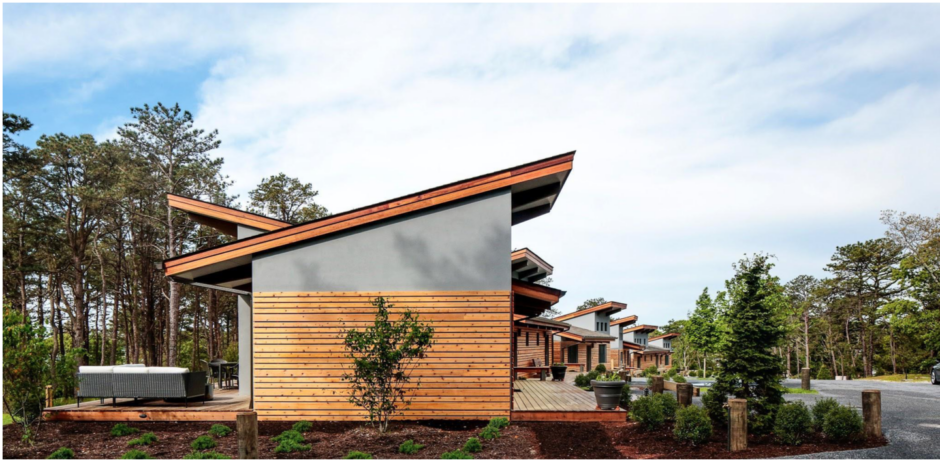
THE HAMPTON MAID
Richard Stott, AIA, LEED AP
Juror Comments: The jury appreciated the thoughtful social considerations represented by The Hampton Maid. Specifically related to the scale of the buildings and the good use of the space. They acknowledged the smaller space living for short-term housing and rental properties such as this could be a model for long-term residential communities in our region. Noted for interesting use of modular elements, good orientation, energy recovery, and a smart use of materials.
——————————————-
Credits & website link at end of portfolio.
=============================================
Sustainable Architecture Merit Award
——————
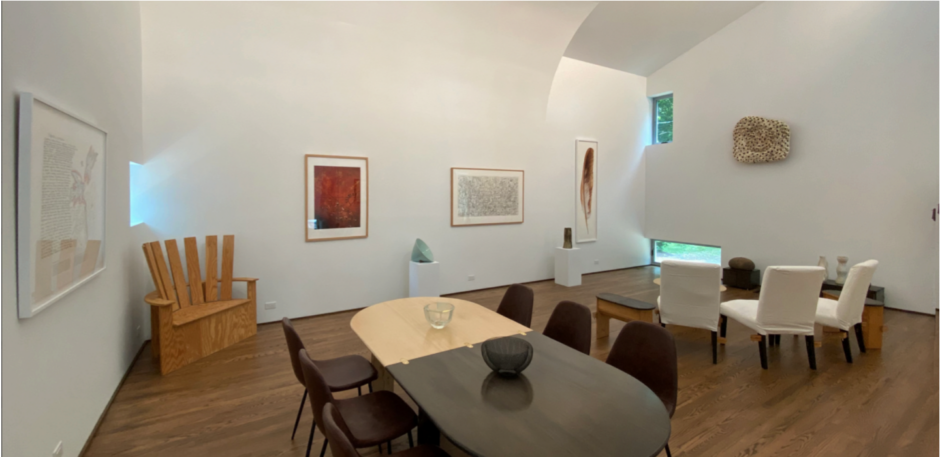
DIFFUSING HUT
Hideaki Ariizumi, studio a/b architects
Project Description
Small house for a residence/office/personal gallery, 29’x29’ square plan with a loft and a detached garage.
The site is in a coastal, woody, older subdivision of cottages on tiny lots. The houses are closely hemmed in by boats, sheds, fences. Here on a small lot, contemporary exterior form would be a violent alien. This site condition lets us think “soft to community and design internally; back to internal architecture.”
After a series of explorations on “openings” for interior-exterior relationship, the focus was shifted to “devices and geometry” for light diffusions and reflections. That shift opened the way to go further inward.
No views are expected from the first-floor level where only a few small windows are allocated. Instead, we obtain expansive volume and a large wall area, perfect for art display. While the first floor became a semi-enclosed space, the loft level with horizontal row of windows resembles a crow’s nest with distant views of waters amidst the treetops.
Reflected off a light-shelf all along a row of loft windows, sunlight will be conveyed into the interior on loft level, and onto the curved ceiling, which diffuses light to the lower floor. Under the curved ceiling, the sunlight will be reflected by the white stained loft floor, diffused by translucent railing panels between the storage cabinets. While cabinets are silhouetted in the view from below, the soft indirect light fills the space smoothly, evenly, calmly. And occasionally, an unexpected light scene appears on the ceiling and walls. Small corner windows on the side walls inject indirect light onto the north wall, and sometimes, a low angled west light catches the window, casts straight line from west to east ends. We find an experiential sunlight observatory in a single box house.
The simple form was perfect to apply a Passive House strategy. A double-walled frame construction incorporates high performance insulation, windows and doors. The all-electric home uses energy-star appliances, LED lights, a hi-performance water heater, an ERV, and WaterSense plumbing fixtures. Inline duct fans draw warm air from the top of the space into the insulated basement, through a dehumidifier, and circulates back. The sanitary system incorporates two septic tanks to isolate the toilet waste to passively contain excess nitrogen.
————
Juror Comments: Diffusing Hut has strong directives in terms of its cladding and materiality.
——————————————-
Credits & website link at end of portfolio.
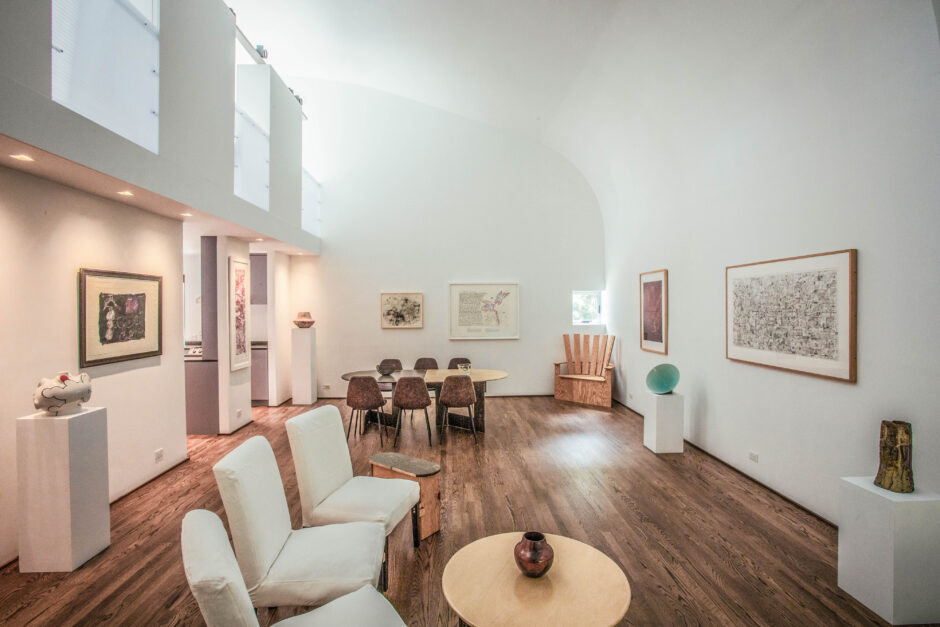
=============================================
People’s Choice Award
——————

SOUTHAMPTON OCEANFRONT
Blaze Makoid, BMA Architects
——————————————-
Credits & website link at end of portfolio.
——————————
========================================
———————————— CREDITS ————————————
AIA Peconic — Project / Architect /Project Team
————————–
2024 Architecture Honor Award

www.batesmasi.com
THREE MILE HARBOR
Architecture Honor Award
Paul Masi AIA, Bates Masi + Architects LLC
========================================
2024 Architecture Honor Award

www.batesmasi.com
Navy Beach / Bates Masi + Architects
—– LSM Develpment
—– James C Grimes Lanscape Design,
2024 Architecture Merit Award

www.stelleco.com
OCEAN BLUFF: Architecture Merit Award
Michael Lomont, Stelle Lomont Rouhani Architects
—– Architects: Michael Lomont, Jared London, and Jonathan Walker.
—– LaGuardia Design, Landscape Architect
—– Eleanor Donnelly / SLR, Interior Design
—–Ronald Webb Builders, GC
—–Glen Alsop, Architectural Photographer
========================================

www.stelleco.com
SPRINGY BANKS: Architecture Merit Award
Viola Rouhani AIA, Stelle Lomont Rouhani Architects
—– Brad Ford, Interior Design
—– Men at Work Construction, GC
—– LaGuardia Design Group, Landscape Architecture
—– Glen Alsop, Architectural Photographer
========================================

www.bassarchitect.com
ROUND HOUSE: Historic Preservation and Adaptive Reuse Merit Award
Stuart Basseches, AIA
—– Witty & Gazda, General Contractor
—– John Imperatore + Susan Harder, Owners
========================================

www.ozasabbeth.com
BRIDGE GARDENS: Unbuilt Projects Juror Award
Nilay Oza AIA, Oza Sabbeth Architects
========================================

www.stottarchitecture.com
THE HAMPTON MAID: Sustainable Architecture Honor Award
Richard Stott, AIA, LEED AP
—– Tom Quarty, Quarty Construction General Contractor
—– Vincent Capogna, Synergy ICF Contractor
—– Araiys Design, Landscape Architecture
========================================

www.ariizumiberry.com
DIFFUSING HUT
Sustainable Architecture Merit Award
Hideaki Ariizumi, studio a/b architects
—– Glynis Berry is credited as a partner on this project.
————————
Visit: AAQ / Architectural Resolutions
— Diffusing Hut, East Marion | studio a/b architects — link
========================================

SOUTHAMPTON OCEANFRONT
People’s Choice Award
Blaze Makoid, BMA Architects
—– Wright & Co. Construction
—– LaGuardia Design Group, Landscape Architect
—– Michael Stavaridis, Project Photographer
========================================

AIA Peconic is a chapter of the American Institute of Architects, a local non-profit organization of architectural professionals, associates and affiliates working on the East End of Long Island dedicated to professional development, design excellence and public outreach within this unique geographic and cultural area.
www.aiapeconic.org
———————————————————
=================AAQ / Resource Plates=================
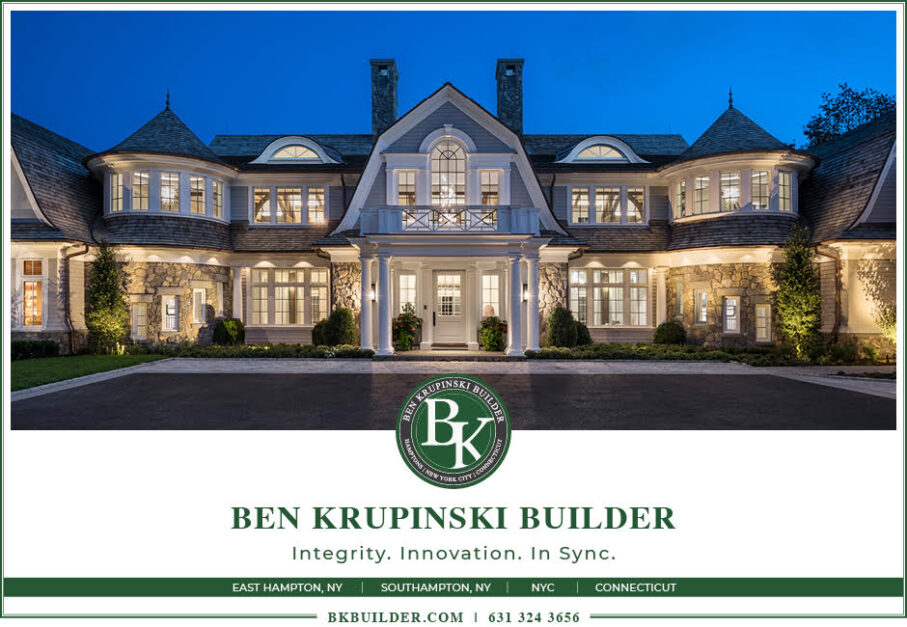
AAQ / Resource: Ben Krupinski Builder
========================================================
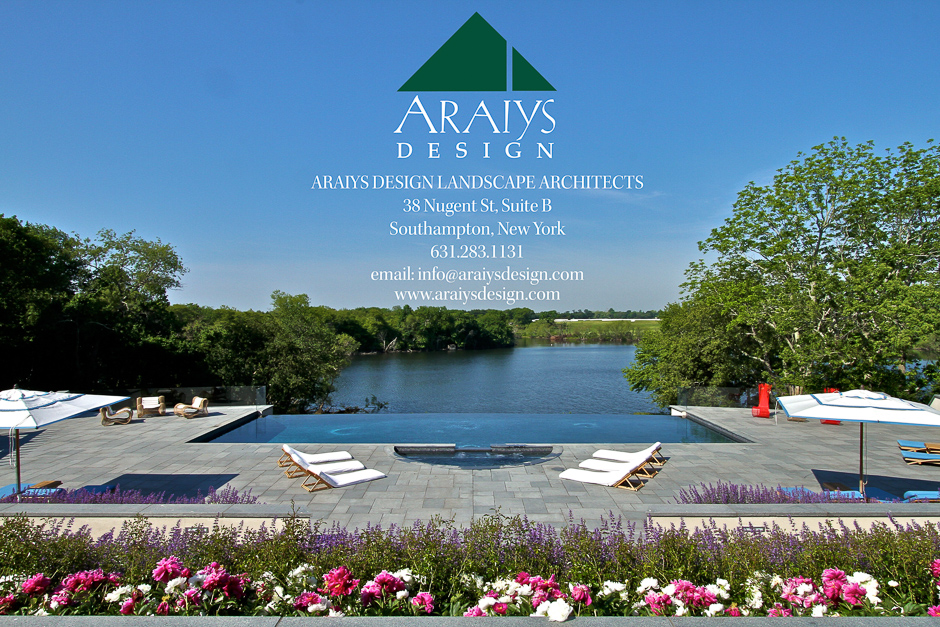
AAQ / Resource
Araiys Design Landscape Architects
========================================================

Art & Architecture Quarterly / East End
————————
Visit AAQ / Architecture
——————
AIA Peconic: 2023 Daniel J. Rowen Memorial Design Awards — link / 2023
————
AIA Peconic: 2022 Daniel J. Rowen Memorial Design Awards — link / 2022
————
AIA Peconic: 2021 Daniel J. Rowen Memorial Design Awards — link / 2021
————
AIA Peconic: 2020 Daniel J. Rowen Memorial Design Awards — link / 2020
————
AIA Peconic: 2018 Daniel J. Rowen Memorial Design Awards — link / 2018
————
AIA Peconic: 2017 Daniel J. Rowen Memorial Design Awards — link / 2017
————
AIA Peconic: 2016 Daniel J. Rowen Memorial Design Awards — link / 2016
————
AIA Peconic: 2015 Daniel J. Rowen Memorial Design Awards — link / 2015
————
AIA Peconic: 2014 Daniel J. Rowen Memorial Design Awards — link / 2014
————
AIA Peconic: 2013 Daniel J. Rowen Memorial Design Awards — link / 2013
——————
© Art & Architecture Quarterly / 2024
_______________________________________________________


